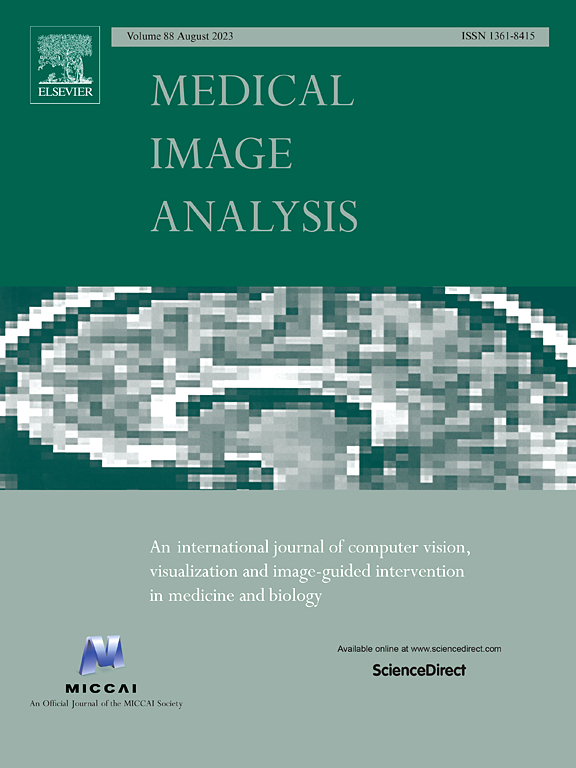Simulation-free prediction of atrial fibrillation inducibility with the fibrotic kernel signature
IF 11.8
1区 医学
Q1 COMPUTER SCIENCE, ARTIFICIAL INTELLIGENCE
引用次数: 0
Abstract
Computational models of atrial fibrillation (AF) can help improve success rates of interventions, such as ablation. However, evaluating the efficacy of different treatments requires performing multiple costly simulations by pacing at different points and checking whether AF has been induced or not, hindering the clinical application of these models. In this work, we propose a classification method that can predict AF inducibility in patient-specific cardiac models without running additional simulations. Our methodology does not require re-training when changing atrial anatomy or fibrotic patterns. To achieve this, we develop a set of features given by a variant of the heat kernel signature that incorporates fibrotic pattern information and fiber orientations: the fibrotic kernel signature (FKS). The FKS is faster to compute than a single AF simulation, and when paired with machine learning classifiers, it can predict AF inducibility in the entire domain. To learn the relationship between the FKS and AF inducibility, we performed 2371 AF simulations comprising 6 different anatomies and various fibrotic patterns, which we split into training and a testing set. We obtain a median F1 score of 85.2% in test set and we can predict the overall inducibility with a mean absolute error of 2.76 percent points, which is lower than alternative methods. We think our method can significantly speed-up the calculations of AF inducibility, which is crucial to optimize therapies for AF within clinical timelines. An example of the FKS for an open source model is provided in https://github.com/tbanduc/FKS_AtrialModel_Ferrer.git.
利用纤维核特征对心房颤动诱发性进行免模拟预测
心房颤动(房颤)的计算模型有助于提高消融等干预措施的成功率。然而,评估不同治疗方法的疗效需要在不同点进行起搏并检查房颤是否被诱发,从而进行多次昂贵的模拟,这阻碍了这些模型的临床应用。在这项工作中,我们提出了一种分类方法,无需运行额外的模拟,即可预测患者特定心脏模型中的房颤诱导性。在改变心房解剖或纤维化模式时,我们的方法不需要重新训练。为此,我们开发了一套由热核特征变体给出的特征,其中包含纤维化模式信息和纤维方向:纤维化核特征(FKS)。FKS 的计算速度比单一房颤模拟更快,与机器学习分类器搭配使用时,可预测整个领域的房颤诱发率。为了了解 FKS 与房颤诱发率之间的关系,我们进行了 2371 次房颤模拟,包括 6 种不同的解剖结构和各种纤维化模式,并将其分为训练集和测试集。在测试集中,我们获得了 85.2% 的中位 F1 分数,我们可以预测总体诱导性,平均绝对误差为 2.76 个百分点,低于其他方法。我们认为,我们的方法可以大大加快房颤诱导性的计算速度,这对于在临床时限内优化房颤疗法至关重要。https://github.com/tbanduc/FKS_AtrialModel_Ferrer.git 中提供了一个开源模型的 FKS 示例。
本文章由计算机程序翻译,如有差异,请以英文原文为准。
求助全文
约1分钟内获得全文
求助全文
来源期刊

Medical image analysis
工程技术-工程:生物医学
CiteScore
22.10
自引率
6.40%
发文量
309
审稿时长
6.6 months
期刊介绍:
Medical Image Analysis serves as a platform for sharing new research findings in the realm of medical and biological image analysis, with a focus on applications of computer vision, virtual reality, and robotics to biomedical imaging challenges. The journal prioritizes the publication of high-quality, original papers contributing to the fundamental science of processing, analyzing, and utilizing medical and biological images. It welcomes approaches utilizing biomedical image datasets across all spatial scales, from molecular/cellular imaging to tissue/organ imaging.
 求助内容:
求助内容: 应助结果提醒方式:
应助结果提醒方式:


